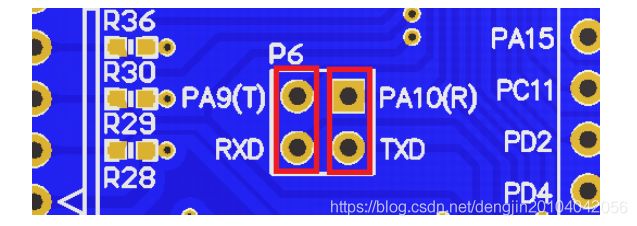【STM32】串口通信编程
00. 目录
文章目录
- 00. 目录
- 01. STM32F4串口简介
- 02. 硬件设计
- 03. 串口设置步骤
- 04. 程序示例一
- 05. 程序示例二
- 06. 附录
- 07. 声明
01. STM32F4串口简介
STM32F4 的串口资源相当丰富的,功能也相当强劲。ALIENTEK 探索者 STM32F4 开发板所使用的 STM32F407ZGT6 最多可提供 6 路串口,有分数波特率发生器、支持同步单线通信和半双工单线通讯、支持 LIN、支持调制解调器操作、智能卡协议和 IrDA SIR ENDEC 规范、具有 DMA 等。
02. 硬件设计
串口 1 与USB 串口并没有在 PCB上连接在一起,需要通过跳线帽来连接一下。这里我们把 P6 的 RXD 和 TXD 用跳线帽与 PA9 和 PA10 连接起来。

03. 串口设置步骤
① 串口时钟使能,GPIO 时钟使能
② 设置引脚复用器映射
③ GPIO 端口初始化设置
④ 串口参数初始化
⑤ 初始化 NVIC 并且开启中断
⑥ 使能串口
串口时钟和GPIO时钟使能
//使能GPIO时钟 PA9 PA10
RCC_AHB1PeriphClockCmd(RCC_AHB1Periph_GPIOA, ENABLE);
//使能USART时钟
RCC_APB2PeriphClockCmd(RCC_APB2Periph_USART1, ENABLE);
设置引脚复用器映射
//设置GPIO复用
GPIO_PinAFConfig(GPIOA, GPIO_PinSource9, GPIO_AF_USART1);
GPIO_PinAFConfig(GPIOA, GPIO_PinSource10, GPIO_AF_USART1);
GPIO端口初始化
//初始化GPIO
GPIO_InitStruct.GPIO_Mode = GPIO_Mode_AF;
GPIO_InitStruct.GPIO_Pin = GPIO_Pin_9 | GPIO_Pin_10;
GPIO_InitStruct.GPIO_OType = GPIO_OType_PP;
GPIO_InitStruct.GPIO_PuPd = GPIO_PuPd_UP;
GPIO_InitStruct.GPIO_Speed = GPIO_Speed_50MHz;
GPIO_Init(GPIOA, &GPIO_InitStruct);
串口初始化
//串口初始化
USART_InitStruct.USART_BaudRate = 115200;
USART_InitStruct.USART_HardwareFlowControl = USART_HardwareFlowControl_None;
USART_InitStruct.USART_Mode = USART_Mode_Rx | USART_Mode_Tx;
USART_InitStruct.USART_Parity = USART_Parity_No;
USART_InitStruct.USART_StopBits = USART_StopBits_1;
USART_InitStruct.USART_WordLength = USART_WordLength_8b;
USART_Init(USART1, &USART_InitStruct);
使能串口
//使能串口
USART_Cmd(USART1, ENABLE);
数据发送
USART_SendData(USART1, 'A');
数据接收
ch = USART_ReceiveData(USART1);
04. 程序示例一
通过串口发送数据
#include "stm32f4xx.h"
#include "delay.h"
#include "led.h"
#include "beep.h"
#include "key.h"
//Key0 控制LED1 Key1控制LED2
int main(void)
{
GPIO_InitTypeDef GPIO_InitStruct;
USART_InitTypeDef USART_InitStruct;
//初始化
delay_init(168);
LED_Init();
//使能GPIO时钟 PA9 PA10
RCC_AHB1PeriphClockCmd(RCC_AHB1Periph_GPIOA, ENABLE);
//使能USART时钟
RCC_APB2PeriphClockCmd(RCC_APB2Periph_USART1, ENABLE);
//设置GPIO复用
GPIO_PinAFConfig(GPIOA, GPIO_PinSource9, GPIO_AF_USART1);
GPIO_PinAFConfig(GPIOA, GPIO_PinSource10, GPIO_AF_USART1);
//初始化GPIO
GPIO_InitStruct.GPIO_Mode = GPIO_Mode_AF;
GPIO_InitStruct.GPIO_Pin = GPIO_Pin_9 | GPIO_Pin_10;
GPIO_InitStruct.GPIO_OType = GPIO_OType_PP;
GPIO_InitStruct.GPIO_PuPd = GPIO_PuPd_UP;
GPIO_InitStruct.GPIO_Speed = GPIO_Speed_50MHz;
GPIO_Init(GPIOA, &GPIO_InitStruct);
//串口初始化
USART_InitStruct.USART_BaudRate = 115200;
USART_InitStruct.USART_HardwareFlowControl = USART_HardwareFlowControl_None;
USART_InitStruct.USART_Mode = USART_Mode_Rx | USART_Mode_Tx;
USART_InitStruct.USART_Parity = USART_Parity_No;
USART_InitStruct.USART_StopBits = USART_StopBits_1;
USART_InitStruct.USART_WordLength = USART_WordLength_8b;
USART_Init(USART1, &USART_InitStruct);
//使能串口
USART_Cmd(USART1, ENABLE);
//数据发送
while(1)
{
USART_SendData(USART1, 'A');
delay_ms(1000);
}
}
05. 程序示例二
通过串口接收数据
#include "stm32f4xx.h"
#include "delay.h"
#include "led.h"
#include "beep.h"
#include "key.h"
//Key0 控制LED1 Key1控制LED2
int main(void)
{
uint16_t ch;
GPIO_InitTypeDef GPIO_InitStruct;
USART_InitTypeDef USART_InitStruct;
//初始化
delay_init(168);
LED_Init();
//使能GPIO时钟 PA9 PA10
RCC_AHB1PeriphClockCmd(RCC_AHB1Periph_GPIOA, ENABLE);
//使能USART时钟
RCC_APB2PeriphClockCmd(RCC_APB2Periph_USART1, ENABLE);
//设置GPIO复用
GPIO_PinAFConfig(GPIOA, GPIO_PinSource9, GPIO_AF_USART1);
GPIO_PinAFConfig(GPIOA, GPIO_PinSource10, GPIO_AF_USART1);
//初始化GPIO
GPIO_InitStruct.GPIO_Mode = GPIO_Mode_AF;
GPIO_InitStruct.GPIO_Pin = GPIO_Pin_9 | GPIO_Pin_10;
GPIO_InitStruct.GPIO_OType = GPIO_OType_PP;
GPIO_InitStruct.GPIO_PuPd = GPIO_PuPd_UP;
GPIO_InitStruct.GPIO_Speed = GPIO_Speed_50MHz;
GPIO_Init(GPIOA, &GPIO_InitStruct);
//串口初始化
USART_InitStruct.USART_BaudRate = 115200;
USART_InitStruct.USART_HardwareFlowControl = USART_HardwareFlowControl_None;
USART_InitStruct.USART_Mode = USART_Mode_Rx | USART_Mode_Tx;
USART_InitStruct.USART_Parity = USART_Parity_No;
USART_InitStruct.USART_StopBits = USART_StopBits_1;
USART_InitStruct.USART_WordLength = USART_WordLength_8b;
USART_Init(USART1, &USART_InitStruct);
//使能串口
USART_Cmd(USART1, ENABLE);
//数据发送
while(1)
{
ch = USART_ReceiveData(USART1);
if (ch == '1')
{
LED1 = 1;
LED2 = 1;
}
else if (ch == '0')
{
LED1 = 0;
LED2 = 0;
}
}
}
06. 附录
6.1 【STM32】STM32系列教程汇总
网址:【STM32】STM32系列教程汇总
6.2 XCOM V2.6串口调试助手
描述:串口调试助手软件XCOM V2.6,免安装版本。
下载:XCOM V2.6.rar